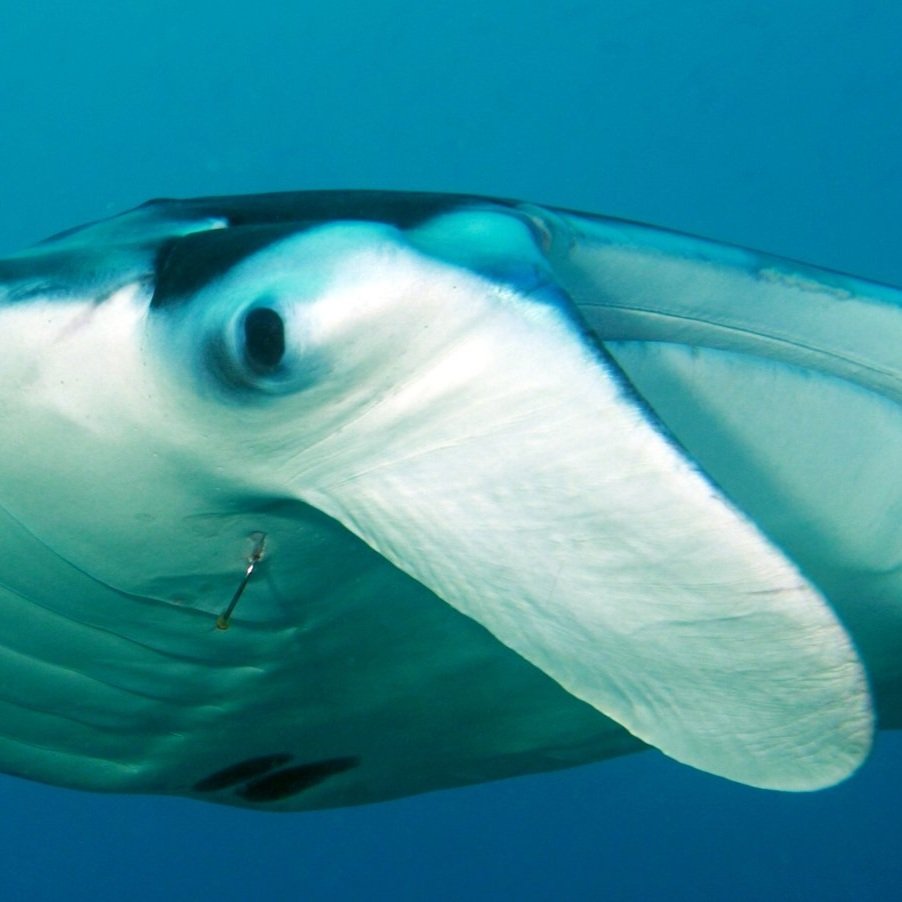
Threats to Mantas
Boats
Mantas come close to the surface when they feed, and many of the mantas we see at German Channel have scars from propellers and boat strikes. Boats should not drive over the manta feeding area, and snorkelers and divers should swim in and out from the mooring buoys. Manta sightseeing from boats should be avoided, and boats need to slow down when passing known manta feeding areas.
Fishing
Mantas often swim into fishing lines and hooks by accident, and these will tear right through their soft rubbery skin, causing terrible wounds. Boat operators should not troll or cast around known manta feeding areas. At least four German Channel mantas were seen with fish hooks and lines caught in their gills and mouths last year.
Sharks
Many of the Palauan mantas show large bite marks and scars from shark bites, and have bitten off tails. Sharks are the main natural predators of mantas. Usually the bites are on the back wings, since the manta’s vision toward their back is not very good. Therefore, never try to swim up to a manta close from behind, they will be spooked easily.
Tourism Pressure
Palau is lucky to have so many mantas, but the pressure of the increased number of divers and snorkelers and their behavior around the mantas at German Channel and Devilfish City could easily scare the animals away from their traditional feeding and cleaning spots there. It is very important for Palauan guides to brief tourists properly before a manta encounter. Tourists seeing a manta for the first time cannot be expected to know what to do and not do. Read below for best practices to keep yourself and the mantas safe:
Important things to remember when you see a Manta…
Do not chase or touch a manta. You cannot keep up with them, and they will come close and keep coming back if not disturbed. When at a cleaning station, stay at least 15 feet away to give the manta space, and do not block their way in and out of the station area. Strobes should be kept to a minimum and toned down.
When mantas are feeding near the surface, keep groups of divers close together to reduce the bubble curtain which creates an obstacle course for mantas. At German Channel mantas feed around the bait ball of fish, so stay on the sides of the fish ball, NOT under or in front of it, since you will scatter the fish, block the mantas from their feeding route, and mess up the experience for other divers who will see only bubbles.
When snorkeling, tourists should stay flat on the surface without “duck-diving” down or splashing around, and should swim back to the mooring buoys, so boats do not have to pick them up between feeding mantas. Boats should not be driving over feeding mantas while dragging snorkelers or non-swimmers on ropes.
Do not use reef hooks or safety sausages in a manta feeding area. They cannot see lines well, and have been tangled in these. When ready to surface, swim away from the manta area before inflating a safety sausage. One manta died November 2010 when tangled in a boat mooring line at Blue Corner.
Reports & Regulations
German Channel Report 2015
Recommendations to protect German Channel- by The Earth Institute, Columbia University & Manta Trust in Partnership with the Save Our Seas Foundation
No Boat Zone Regulations
No Boat Zone regulations by Koror State Government to protect manta rays, their habitats, and to minimize disturbance to their natural behavior.






